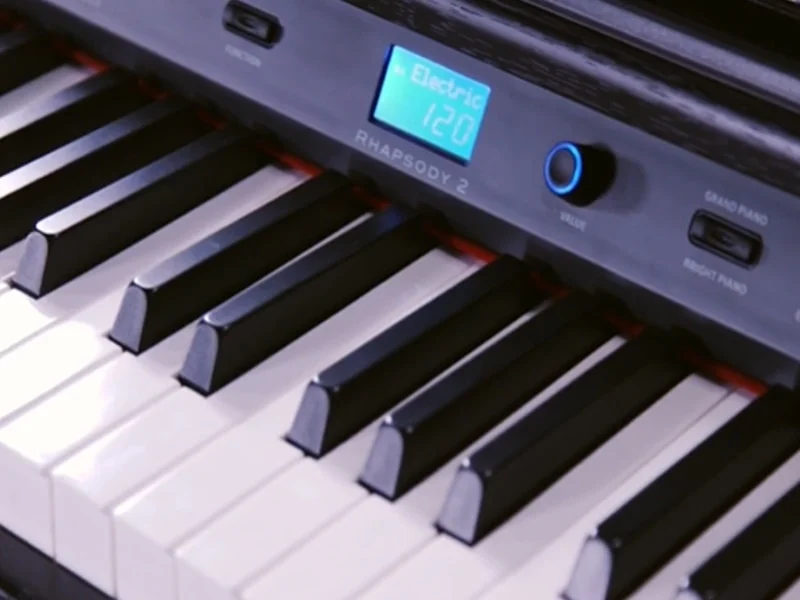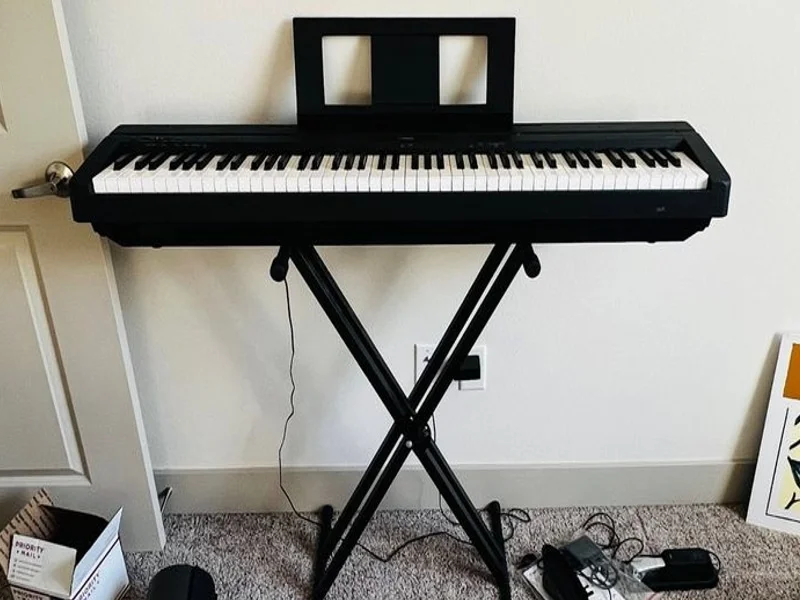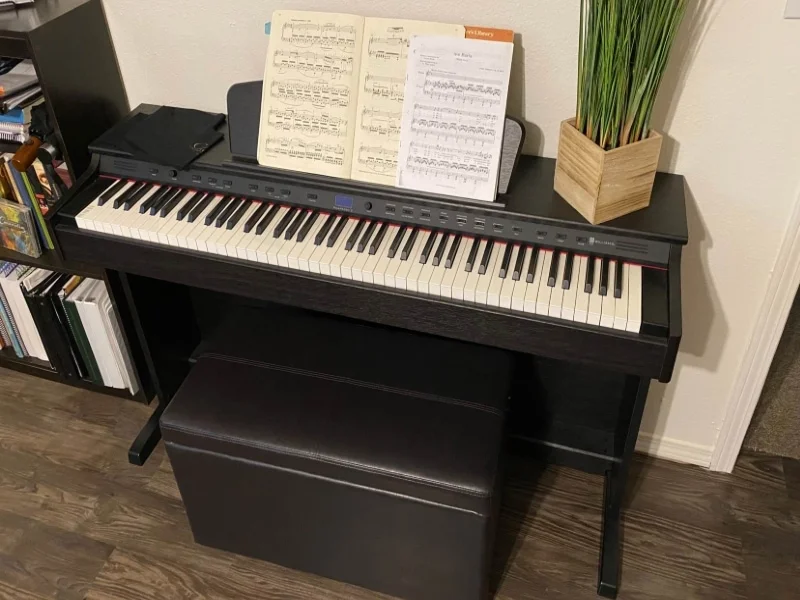Find the best piano for your needs in this Yamaha P45 vs Williams Rhapsody II review!
If you’re looking for a new digital piano, there’s a high chance you’re choosing between a portable or console model. Both have their advantages, and it’s really up to your needs as a pianist when finding the right one.
And to give you a better idea of which piano better fits your needs, I’ll compare two popular models for many beginners: The Yamaha P45 and the Williams Rhapsody II. These are two very different instruments, and each has its set of perks.
But between the two, I found that the Yamaha P45 was the better option. It had richer tones and a more realistic feel. And since it’s portable, it’s also a very flexible option for pianists.
That said, the Williams Rhapsody still has some benefits that may suit your needs better. So, let’s dive into the details so you can determine the best option for you!
Yamaha P45 vs Williams Rhapsody II: Comparison Chart


Last update on 2025-04-12 / Affiliate links / Images from Amazon Product Advertising API
Yamaha P45 vs Williams Rhapsody II: The Features
To find the better piano between the two, I decided to compare all the features against each other. And by the end of this comparison, the Yamaha P45 came out on top with a score of 3-2. It was a close battle, but there was no denying that the Yamaha P45 offered more benefits than the Williams Rhapsody II, which is why it ultimately came out on top.
Tone
The winner: Tie
The first feature I compared between the two was the tone. You always want to make sure you buy a digital piano that can replicate an acoustic piano’s sound while offering other voices. And after rigorous testing and research, I couldn’t choose a winner between the two.
There was no doubt that the Yamaha P45 had richer tones because of the tone generator. However, the Williams Rhapsody II came with more voices, which is why they both came out with a point in this comparison.
+Sound Library

Most of the time, console digital pianos have fewer voices than portable ones. But with these pianos, it’s the opposite. I was quite surprised, but the Yamaha P45 actually has lesser voices than the Rhapsody II.
The Williams Rhapsody II comes with 12 different voices. This isn’t a lot, and many other pianos have more options. However, it is a bit more than the P45, which only comes with 10 different voices.
That said, both the P45 and the Rhapsody II come with a similar sound library. While you have more options with the Rhapsody II, they both come with piano, electric piano, strings, synth, and organ voices.
So, if you’re looking for more voicing options in a digital piano, the Rhapsody II might actually be what you need.
+Tone Generation
The Williams model comes with more voices. But if tone quality is your main concern, the Yamaha P45 is the better pick. This is because the Yamaha P45 uses the Advanced Wave Memory or AWM tone generator, which is Yamaha’s affordable but highly realistic tone engine.
When you play the Yamaha P45, you’ll instantly notice richer and brighter piano tones. And when I tested out both models from the same speaker system, the Yamaha P45 clearly had higher-quality sounds, and it was no argument.
However, the Williams Rhapsody II still had decent voices. In fact, the tone quality from the Williams was surprisingly good, considering its price point. But when compared to the Yamaha P45, it was clear that the Williams didn’t have tones that were as rich and realistic.
Feel & Playability
The winner: Yamaha P45
Another aspect I had to consider when comparing the two options was playability. This is where the Yamaha P45 truly shined, as the incredible hammer action on this piano was far ahead of the Williams Rhapsody II.

+Hammer Action
The Yamaha P45 uses the Graded Hammer Standard or GHS. This is a staple feature of many Yamaha pianos, from their affordable to their mid-range options. This hammer action system is designed to easily replicate the feel and weight you get when playing a real acoustic piano.
So, aside from weighted keys, you have subtle differences in the hammer action. This is why you might notice that the lower keys are heavier than the higher ones when playing the Yamaha P45, the same as an acoustic piano.
On the flip side, the Williams Rhapsody has basic weighted keys. Granted, this still provides a fairly realistic feel. However, I must admit it was missing the subtle weight differences I noticed on the Yamaha P45.
Piano Features
The winner: Tie
The last comparison point I had with these two pianos was the actual piano features. And I declared this category a tie because the Yamaha P45 comes with more useful playing modes, but the Williams Rhapsody II comes with better effects.
+Playing Modes
The Yamaha P45 comes with two playing modes: dual and duo modes. Dual mode is also called layering mode, allowing you to layer or combine two voices. For example, you can mix strings and piano voices. That way, your tone has more body and depth whenever you press a key, which is a great feature when performing live or accompanying another musician.
Duo mode, on the other hand, is designed for duets and piano lessons. This mode splits the piano in the middle. So, it’s like you have two mini keyboards with the exact same tuning and timbre.
That way, you and another pianist can play together as if you had two pianos. This is a really cool feature for piano duets that can also make piano lessons with your teacher much easier.
And while the Williams Rhapsody II comes with many dual modes, it doesn’t come with duo modes. Instead, it comes with split mode. This allows you to assign different voices to either side of the piano.
This is a very useful feature. However, if you’re a beginner, this isn’t something you’ll use a lot, which is why the Yamaha P45 was the winner when I compared the playing modes.
+Effects
I was fairly surprised to learn that the Rhapsody II came with more effects than the Yamaha P45. The Rhapsody II comes with reverb and chorus effects, while the Yamaha P45 only comes with reverb. And even if reverb is one of the most useful effects for a pianist to have, the chorus effect on the Rhapsody II gives you a bit more control over your tone.

Yamaha P45 vs Williams Rhapsody II: The Similarities
These are two different pianos designed for various needs. And the differences between the two were why I decided to make this comparison. However, when learning as much as I could about the pianos, I found that they also share a couple of similarities.
To start, both pianos have a maximum polyphony of 64-notes. This is great for an entry-level digital piano and allows you to play multiple notes at the same time with amazing clarity. While higher-end pianos come with higher maximum polyphony, 64-note polyphony is great for beginners and novice pianists.
Additionally, both pianos have fairly decent speaker systems. I found that the tones from either instrument sounded great on the built-in speakers. And while neither of the speakers would be loud enough for live performances, it’s great for practice and piano lessons.
At the end of the day, I found the Yamaha P45 to be the more flexible option, which is why it ultimately won the comparison. But if you need a high-quality console digital piano on a budget, the Williams Rhapsody II is still a great pick.
Quick Rundown of the Yamaha P45
- Includes the P45 Digital Piano, power adapter, sustain pedal and music rest
- 88 fully weighted piano style keys simulate the feel of an acoustic piano and provide a quality playing experience
- GHS weighted action is heavier in the low end and lighter in the high end, just like an acoustic piano
- Contains 10 different voices, including digitally sampled tones from real Yamaha acoustic grand pianos
- Dual mode lets you combine 2 voices together, like piano and strings, for an inspiring new playing experience. Tuning- 414.8 - 440.0 - 446.8 Hz
Last update on 2025-04-12 / Affiliate links / Images from Amazon Product Advertising API
Quick Rundown of the Williams Rhapsody II
No products found.
Product Videos
Related Articles to Yamaha P45
- Yamaha P45 vs P45B: What’s the Real Difference?
- Yamaha P45 vs DGX-650: Is the DGX-650 Worth the Higher Price?
- Yamaha P-35B vs P45: Finding the Best Affordable Yamaha Piano
- Yamaha P45 Vs DGX-660: A Head-to-Head Comparison
- Yamaha P45 Vs NP32: A Head-to-Head Comparison
- Yamaha P45 vs Williams Allegro III: Finding the Best Digital Piano on a Budget
- Yamaha P45 vs YPG 535: Which Is the Best Affordable Yamaha Piano?
- Yamaha P60 vs P45: Finding the Best Yamaha Portable Digital Piano
- Yamaha P45 vs P105: Should You Spend Extra for the P105?
- Alesis Recital Vs Yamaha P45: Which Offers Great Value For Money?
- Donner DEP-10 Vs Yamaha P-45: Which Digital Piano Is Better?
- Yamaha P45 Vs Korg B2: Which Digital Piano Fits Beginners Better?
- Yamaha P45 VS P115: Which P-Series Newbie Gives You More Value for Money?
- Yamaha P45 vs Casio CDP S100: Finding the Better Bet for Beginners
- Yamaha P45 vs YDP 103: Should You Get a Portable or Console Digital Piano?
- Alesis Recital Pro vs Yamaha P45: Which Should You Get As Your First Piano?
- Yamaha P45 vs Roland FP10: Which Entry Level Titan Takes the Top Spot?
- Yamaha P45 vs Donner DEP 20: Which Model Is the Better Option for Beginners?
- Yamaha P45 vs Casio PX 770: Should You Get the Portable or Console Digital Piano?
- Alesis Prestige Artist vs Yamaha P45: Can Alesis Hold Its Own Against the Popular Yamaha Model?
- Yamaha P45 vs P125: Why the Yamaha P125 Is the Better Pick for Pianists
- Yamaha P71 vs P45: Why the Amazon Exclusive P71 is the Better Digital Piano
References:
- Yamaha P45: https://usa.yamaha.com/products/musical_instruments/pianos/p_series/p-45/specs.html#product-tabs
- Williams Rhapsody II: https://williamspianos.com/wp-content/uploads/usermanuals/Williams_Rhapsody2_Manual.pdf
Lulacruza is an electronic folk duo operating at the junction of the hypermodern and the ancient. Our music weaves together hypnotic female singing, South American folk instruments and electronic processing, while channeling pulsating waves from the source of creation.
Lalucruza is also a community where you can connect with other music lovers to collaborate, exchange ideas and share knowledge. A platform for who wants to learns the basics of playing piano, guitar, drum masters’ technique, etc.. is the premise of our website.
